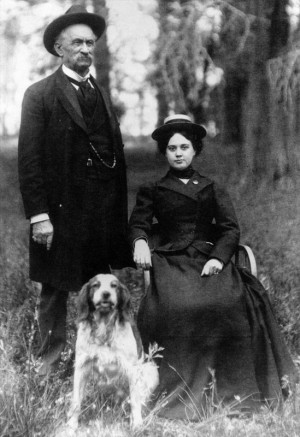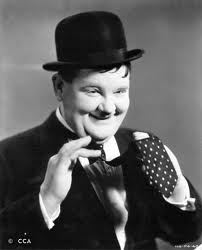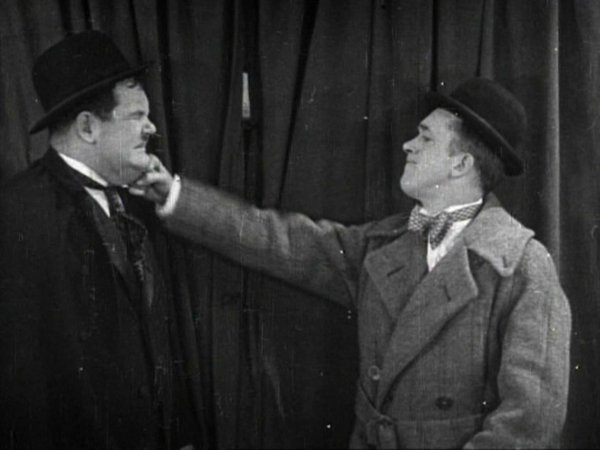L.A.’s first official racetrack was opened in 1904 by gold prospector, Elias Jackson “Lucky” Baldwin. Baldwin owned an enormous tract of land, the Rancho Santa Anita, and he was a regular at racetracks across the U.S., both as a gambler and as a horse breeder. No one was surprised when Baldwin founded a racetrack on his property in the early 1900s.

Lucky Baldwin and a woman (likely his fourth wife, sixteen year old Lillie Bennett). Photo courtesy of Los Angeles Public Library.
From newspaper accounts of the time it appears that Baldwin’s death in 1909 ended the racetrack venture – in large part due to squabbles over his estate. Baldwin had left behind a widow, three ex-wives, and several daughters (at least one of whom appeared out of the blue to lay claim to a portion of his multi-million dollar estate). There wouldn’t be another Santa Anita Racetrack until the 1930s.
California legalized pari-mutuel wagering in 1933, and several groups of investors sought to open racetracks. In the San Francisco area a group, headed by Dr. Charles H. “Doc” Strub, was having a difficult time locating a suitable site for a track. In Los Angeles a group of investors, led by movie producer Hal Roach, was in need of additional funds so the two groups combined and formed the Los Angeles Turf Club.
Santa Anita racetrack was designed in the Art Deco style by architect Gordon B. Kaufman. Kaufman had also designed the Los Angeles Times Building, and Greystone mansion (for the Doheny family). The track opened on December 25, 1934 and quickly became a destination for Hollywood’s biggest stars, some of whom, such as Bing Crosby, Joe E. Brown, Al Jolson, and Harry Warner, were stockholders.
On January 4, 1936 Aggie Underwood and photographer Perry Fowler were assigned to the Turf Club at Santa Anita. Across the room they spotted Oliver Hardy, the portly half of the popular comedy team Laurel & Hardy, and they decided to ask him if he’d consent to being photographed.
Perry reached Hardy before Aggie did and said: “Well, Mr. Hardy in person. Will you let us have your picture, Mr. Hardy?” Hardy glanced up from his racing form and answered no; he said he was busy. When Aggie asked him, “Why, Mr. Hardy, won’t you let the Herald-Express have your picture today?” He looked at her and this time answered yes.
Perry reached for his camera, and as he prepared to get the shot he asked Hardy if he was accompanied by his wife or daughter – if so, maybe they’d like to have their photos taken too. Hardy became belligerent and said: “Don’t ask so goddam many questions”. In fairness to Hardy, it’s entirely possible that he was touchy on the subject of marriage because he and his wife Myrtle would divorce that same year. Perry wasn’t sure what to make of Hardy’s comment, and at first he thought that the comedian was kidding. He quickly changed his mind when he saw Hardy’s thunder cloud expression. According to Aggie, Perry told Hardy not to get “so goddam tough”; at which point the situation quickly deteriorated, with the two men about to exchange blows.
Hardy made several pointedly unkind remarks about news photographers and ended by hitting Perry on the shoulder and saying: “Put down that camera and I’ll throw you over that rail and break your goddam neck.” Aggie stepped between the two men before they could start swinging, and suggested to Perry that they leave. They didn’t want Hardy’s picture anyway.
As Aggie and Perry headed for the exit, Hardy took the opportunity to get in the last word. He called out, “PUNK!” Aggie glared at Hardy and said: “I wouldn’t make the situation any worse, if I were you, by calling people names.” Hardy again had to get the last word and said: “I didn’t call any names. I said PUNK and that still goes.”
Back in the newsroom, Aggie figured that it would be a good idea to get the incident on record, just in case there was a phone call from Hardy’s publicist or studio. She and Perry submitted a memo to city editor, Cappy Marek, describing the incident in detail.
Cappy read the memo and became furious – he was an editor who always backed his reporters and photogs. In a huff, Marek got Hardy’s publicist on the phone and in no uncertain terms let him know about the behavior of his client.
Good relations with the press counted for a lot in those days, as Hardy’s publicist must have explained to the cranky comedian. Within a day or two of the Santa Anita incident Cappy Marek received a letter from Oliver Hardy.
 Hardy gave his side of the story which put him in the right, of course. He said that he’d never called Perry names – which got Aggie’s ire up. She repeated to Cappy that she had been present when Hardy had called Perry a punk. She’d heard him loud and clear. Hardy’s explanation didn’t reconcile with Aggie’s version, but she let it go.
Hardy gave his side of the story which put him in the right, of course. He said that he’d never called Perry names – which got Aggie’s ire up. She repeated to Cappy that she had been present when Hardy had called Perry a punk. She’d heard him loud and clear. Hardy’s explanation didn’t reconcile with Aggie’s version, but she let it go.
In her 1949 autobiography, Newspaperwoman, Aggie said that she had observed that “…some folks are handy at offering insults in public and later trying to present apologies in private”. It was her opinion that: “Beyond that no comment is necessary.”




Life imitates art. Before I even got to the meet of this juicy story, I was thinking, “Ah, another supporting player in my favorite movie, the 1937 ‘A Star is Born.’ ” Interesting!
Thank you, Jeannie!
As Oliver Norville Hardy would have said in one of his on-screen escapades with Stan Laurel, “Tut, tut, tut, tut, tut.” Must have been crabby that day. I’ve not heard this story before, Joan. Thanks for giving the L&H fans something new to read. I have to check my L&H books at home, but I think Myrtle was the wife who was often drunk when Ollie came home from work each day.
Amy – yes, poor Oliver, I believe he was having a bad day, and I’d bet it had to do with Myrtle and the divorce. Aggie could be a sweetheart, but she could also be a pit bull when it came to the rights of the press (real or perceived). I think that she believed that Hollywood stars ought to show nothing but gratitude when they were given the opportunity to be photographed for the Herald!
I think this is just another made-up juicy gossip story about a public figure.To quote L&H expert and writer Randy Skretvedt: “Both the behavior and language sound out of character for Hardy. He was very careful about his language off-camera and especially when ladies were present. The other item which is questionable is “Hardy’s publicist”…I doubt if Laurel and Hardy personally ever had a publicist. There was of course a director of publicity at the Hal Roach Studios, Joe Collum (and later a man named Ray Coffin!), so perhaps this is the publicist in question”.
Hans, I don’t believe that it was made up, Aggie didn’t spin yarns out of whole cloth. The item never appeared as a news story so if it was meant to be juicy gossip it wasn’t even seen in print until it appeared as a small anecdote in Aggie’s 1949 autobiography–years after the incident. Publicist in the context of my post is really just a catch-all, it is meant to suggest that someone, a studio exec, manager, etc., may have intervened and asked Hardy to pen an apology. The story doesn’t change anything for me–I’m still a big fan of the boys. Best – Joan
Having known both Mr. Laurel & Mr.Hardy personally, I can tell you that this story is not at all representative elegant, and sensitive gentleman that Mr. Hardy truly was. He was always polite and courteous to those around him, and never refused a photograph or autograph request. They were both my close friends, and Oliver would never do anything akin to behaving like that…….
doooooooo
FINN
James — Aggie told the story about her interaction with Mr. Hardy in her autobiography. It was published in 1949 when Mr. Hardy was still alive and there was no lawsuit and apparently no blow-back; I believe her, there’s no reason not to. Oliver Hardy was only human and it’s possible he simply had a bad day and that’s when he encountered Aggie. It can happen to anyone and the story hasn’t harmed his legacy. I respect your opinion, we just disagree on this. Best — Joan